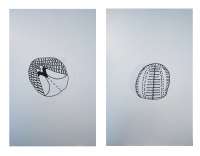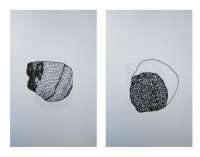3 diaries 9x14 cm (3.5 x 5.5 inches)
This project consists in 3 self reflexive diaries about the Sisyphus Myth. The drawings collection aims to explore the internal process of the self in his cyclically task.
A call for unrealized projects Inês Burguete
This project was born from all the silent inactive hours of reading that took me in to a metaphysic journey. In Odyssey’s Book XI Ulysses arrives to the House of Hades. There he sees the terrible fate of Sisyphus, condemned to the endless task of raising a prodigious stone with both his hands. He tries hard to roll it up to the top of the hill, but every time, just before he reaches the top on to the other side, the weight of the stone becomes too much for him. The stone come thundering down again on to the plain and he has to start all over again Camus is particular interested in Sisyphus’s thoughts when marching down the hill to perpetuate his task. He becomes conscious of his wretched condition and that is his punishment. Camus claims that when Sisyphus aware the meaningless of his action and the certainty of his fate, he is free to realize the absurdity of his situation and to reach a state of contented acceptance. Camus concludes that "all is well", indeed, "one must imagine Sisyphus happy." It is in this eternal return that Sisyphus resembles his burden (he is the stone!). The circular movement changes the condition of the stone per se, transforming, evolving, and opening new possibilities for a fictional existence. The object suffers the influence of its agent, assuming the human and the infinite reflexive ontological thought in its form. The constant mutation endures like the Sisyphus’s task. It is a serpent eating its own tail.
3 diaries 9x14 cm (3.5 x 5.5 inches)
This project consists in 3 self reflexive diaries about the Sisyphus Myth. The drawings collection aims to explore the internal process of the self in his cyclically task.
A call for unrealized projects Inês Burguete
This project was born from all the silent inactive hours of reading that took me in to a metaphysic journey. In Odyssey’s Book XI Ulysses arrives to the House of Hades. There he sees the terrible fate of Sisyphus, condemned to the endless task of raising a prodigious stone with both his hands. He tries hard to roll it up to the top of the hill, but every time, just before he reaches the top on to the other side, the weight of the stone becomes too much for him. The stone come thundering down again on to the plain and he has to start all over again Camus is particular interested in Sisyphus’s thoughts when marching down the hill to perpetuate his task. He becomes conscious of his wretched condition and that is his punishment. Camus claims that when Sisyphus aware the meaningless of his action and the certainty of his fate, he is free to realize the absurdity of his situation and to reach a state of contented acceptance. Camus concludes that "all is well", indeed, "one must imagine Sisyphus happy." It is in this eternal return that Sisyphus resembles his burden (he is the stone!). The circular movement changes the condition of the stone per se, transforming, evolving, and opening new possibilities for a fictional existence. The object suffers the influence of its agent, assuming the human and the infinite reflexive ontological thought in its form. The constant mutation endures like the Sisyphus’s task. It is a serpent eating its own tail.

